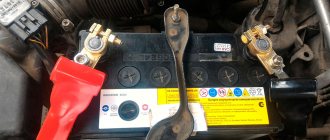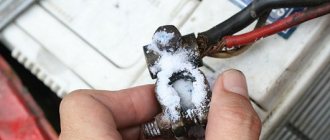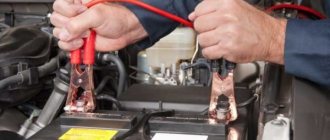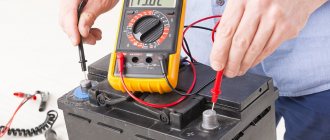A car battery can hardly be classified as equipment in which failures and malfunctions occur very often. But this cannot be ruled out.
The basis for reliable and efficient operation of the battery is maintaining an optimal charge level and the quality of the contact connections at the terminals.
During operation, motorists may notice that the contacts heat up. This is not considered normal, so it is important to determine the cause and try to eliminate it. On your own, or with the help of specialized specialists, is a secondary issue.
What you need to know about terminals
To connect the contact groups of electrical equipment with the battery terminals, metal terminals are used.
These terminals are manufactured in accordance with international standards. They are divided into several types:
- type A;
- B;
- F;
- G;
- T;
- E;
The most common terminals are A and B, and most battery manufacturers use them. Made in the form of metal clamps, necessary for connecting the battery and consumers.
To ensure consistent quality contact, the connection is tightened with screws or bolts with an intermediate nut.
The terminal must meet some key requirements:
- large mass;
- high strength indicators;
- wear resistance;
- maintaining shape during deformation;
- simple design.
But even elements made in strict accordance with international requirements can periodically cause problems for car owners. One of these problems is contact heating.
Oxidation
The process of contact oxidation occurs as a result of the influence of external factors in combination with electrolyte vapor on the surface of the part. As a result of this process, the conductivity of the current is disrupted, which stops the operation of the starter or other electrical devices of the car. Without the starter functioning, the engine will not start. If you do not monitor the appearance of oxide, this incident can occur at any time on the road. Like any other malfunction of electrical contacts, incorrect operation of the terminals as a result of oxidation can also lead to increased heating of the part and fire of nearby elements.
In order to significantly slow down the appearance of oxide on the surface of the element, it is necessary to regularly clean the outer part with fine-grain sandpaper and a special brush, then apply a thick layer of lubricant or spray that prevents the oxidation process. One of the budget-tested ways to prevent the terminals from overheating is to treat them with grease, lithol or Vaseline. Although they are inferior in terms of protection against oxide, they are also an alternative to modern expensive means.
If the terminals get hot, the reasons must be immediately identified and eliminated. Proper care of car parts will increase their service life and, most importantly, make driving safe for the driver and passengers.
Reasons for contact heating
There are several main reasons why the positive or negative terminal on the battery gets hot.
It is important to understand the peculiarities of how a car operates with a battery. When the key is turned in the ignition, the starter is engaged and this allows the engine to start. When starting, a large starting current is transmitted. In some cases, these figures are an impressive 600 Amps.
If there are certain problems, this leads to heating of the battery terminals and terminals.
Experts identify several probable reasons why battery terminals heat up. And both negative and positive.
- Poor quality of contact between the terminal and the battery terminal. These are quite common reasons, due to which the battery terminals often get very hot. This usually happens after long-term use, or it appears on relatively new machines due to a manufacturing defect.
- Formation of oxides on the inner surface of contacts. The negative terminal, like the positive terminal, sometimes heats up due to the appearance of an oxidation film. A common problem with lead-acid batteries. To prevent the appearance of oxides, it is recommended to periodically check the condition of the leads, clean them with brushes or treat them with special sprays.
- Increased resistance of conductors. The probable cause of heating is the positive terminal of the car battery. In this case, it is worth checking the condition of the battery wires. When operating a car, it happens that the wires are refracted. Because of this, conductivity indicators drop, and the passing current contributes to an increase in temperature. In this situation, there are not many options for solving the problem. The damaged wire needs to be replaced.
- Lost connection with the housing. If, when you start the engine, it is the negative terminal from your battery that heats up, pay attention to the quality of the connection between the negative terminal and the vehicle body. In such situations, heating of both the terminal itself and the wires is possible.
- Battery malfunctions. They can provoke oxidation of the terminals and internal surfaces of the terminals and disrupt switching. But in such a situation, the positive terminal will heat up. The solution is simple. This includes cleaning the metal components, as well as replacing the battery itself. You cannot connect a new battery to faulty terminals.
Having figured out the reasons, they will need to be eliminated.
A number of problems can be solved by the motorist himself. But sometimes it is wiser and more logical to turn to specialized specialists.
Before you get started, it is important to understand the dangers of heating.
Danger of heating battery terminals
The increased temperature of the battery contacts poses certain threats to the entire electrical circuit of the car. This phenomenon is fraught with the following consequences:
- the increasing temperature of the current leads can lead to severe overheating of the electrolyte in the battery banks, because of this the working mass dries out and crumbles, and the battery characteristics are significantly reduced;
- periodic heating and cooling of the contacts lead to the fact that the physical properties of the device body change and it is partially deformed;
- an increase in temperature conditions causes gradual deformation of the current conductors themselves;
- battery discharge, which any driver will feel the next time he starts his car’s engine;
- failure of individual components or circuit elements, for example, fuses, diode bridge, and so on;
- Overheating of any part of the circuit can cause a fire.
After starting the power unit, there may not be an increase in temperature at the current terminals. But after the current consumers are turned on (heated mirrors or seats, lighting, audio devices), increased heating of the terminal begins. In some cases, it can be so hot that you can’t even touch it. With so many operating devices, the generator does not handle the increased load. Some of the electricity has to be taken from the battery, and if the contacts are bad, the terminals will overheat.
What is the danger of terminal heating?
There is an opinion among motorists that in a situation where the terminal on the battery terminals (plus and minus) gets hot, there is nothing wrong with this. Supposedly this is a normal phenomenon, since large currents pass through, which provokes an increase in temperature.
In fact, the question of whether the negative or positive terminal should heat up when the battery is running can be answered unequivocally. If the battery is working properly, this should not happen.
In practice, an increase in temperature leads to negative changes in ongoing internal processes. That is, these processes are disrupted, which affects the general condition of the battery and the entire car.
Experts identify several of the most dangerous and likely consequences.
- Increasing the temperature of the internal plates. The lead gets too hot. The plates are in contact with the electrolyte, which, if overheated, will begin to boil and evaporate. As a result, the battery may completely fail. The electrolyte level drops significantly, sometimes to critical levels. The process of shedding the plates begins, the battery capacity is lost, which cannot be restored.
- Cracks and damage appear on the body. If the heat is strong, the plastic may even begin to melt. And through the cracks that appear, electrolyte will begin to leak out. It is no longer possible to solder a damaged case. You'll have to buy a new power source.
- Deformation of terminals and terminals. Again, a consequence of high temperatures that reach critical levels. Lead itself is quite soft, and therefore the melting point is not so high.
Heating of the terminals at the battery terminals is not at all normal. If this happens, you should definitely conduct a comprehensive diagnostics of the battery, determine the cause and try to eliminate it.
How to avoid problems
Here are some simple recommendations that will avoid oxidation of terminals and contacts and save your nerves and battery:
- Inspection and cleaning of terminals. Regularly monitor the condition of the terminals, remove oxides, and ensure that all contact connections are free of dirt and dust. If there is still dirt and oxides, clean it. A brush with metal bristles, emery cloth, and a cloth with gasoline will help you;
- Good contact. Check all contact connections. If there is a leak somewhere or a lot of overheating due to differences in materials, replace it. Also tighten the cleaned terminal clamp that is placed over the terminal tightly.
- Inspect the battery and wiring. If you regularly carry out the previous steps, but oxides appear again and overheating occurs, make sure that your battery is not damaged and that no electrolyte gets on the contacts. Also check the integrity of the wiring and replace damaged pieces of cable.
How to prevent terminals from heating up
If you notice that one or another terminal of your battery is getting very hot, you need to take a number of measures. In general, it is better to comply with them even before the problem itself appears.
The point of preventing overheating is to follow these recommendations:
- Do not use equipment that draws more power or current than the on-board conductors can provide. If you plan to go beyond these limits, then you will need to replace the wiring. Wires with a larger cross-section are used to withstand the increased load.
- Try to monitor the serviceable and working condition of all consumers. This will eliminate the possibility of a short circuit.
- For your car, choose a battery with current leads corresponding to the terminals of the on-board network. In simple words, the battery terminals must match the type of terminals that are used in the car to connect to the battery. Some people use improvised means when they are inappropriate. This is absolutely wrong and can lead to a short circuit, fire, or rupture of the battery case. There are contact groups on sale that allow you to solve the problem of mismatch between battery terminals and standard terminals. These are a kind of adapters.
- Make it a rule to periodically check the ground connection on the battery case, the quality of tightening and fastening of the terminals themselves on the battery. Tighten fasteners as necessary.
- Make sure that no traces of oxides appear on the leads and terminals. They are formed when there are certain problems. It is necessary to establish the cause of oxidation, eliminate it and clean the surfaces.
- Examine the condition of the internal surfaces of the terminals. Cracks, defects and other damage may appear there. They can be treated with fine-grained sandpaper. It is better to replace such terminals. When the internal surfaces wear out when connecting to the battery, a small air gap is formed. This leads to an increase in the internal resistance of the battery and overheating.
In practice, meeting such requirements is not so difficult. This is a job that literally takes a few minutes, which a motorist can devote to his vehicle without any problems.
If the battery cables become hot
It happens that the wire is heated, and the owner of the car thinks that it is the terminal that is heating up. Are there any differences? And they are:
- The quality of the wire is very low;
- the wire cross-section is very weak (with powerful external actions it cannot cope with the assigned load);
- rupture of wires inside the cable itself.
All of the above can subsequently lead to a fire in the wires. because they tend to ignite. In this case, it is best to replace the faulty wires with new, more reliable and high-quality ones.
To do this, it is recommended to use more advanced wires that are reliably protected by both oil- and gasoline-resistant insulation and heat resistance itself. This type is available for cables of European standards.
Please note! Battery terminals must be connected with braided copper wires.
Possible factory defect of the new battery
For novice drivers, it will also be useful to know that the process of boiling the battery itself can tell you why it gets very hot and for what reasons its total voltage does not meet the required standard.
For example, when one of the cans shorts due to a factory defect, boiling occurs as a normal and natural process in all serviceable battery compartments . There is no boiling process in a closed jar. When measuring the density of the electrolyte, its value in the “dead” compartment does not exceed 1.10 g/cm 3 . A battery with such a defect will produce a voltage of about 10.5 Volts, and not the required 12-13 at rest. It is better not to try to restore it, but to return it back to the store, or exchange it for a working one.
Why does my phone battery heat up when charging?
Most often, phone owners’ concerns about this have no serious basis:
- If the phone is charging and there are no obvious signs of overheating, then charging can be safely continued: all mobile phones “heat up” when connected to the network .
- If you make calls, play games or text while your phone is charging , its temperature will naturally be an order of magnitude higher than normal. In this case, you can wait for the device to finish charging so as not to worry again.
- If the body of your gadget is made of metal , it will heat up more, but there is no danger in this.
- When connecting to a smartphone Wi-Fi or any type of mobile Internet, downloading data will affect the temperature level during charging.
- The phone may heat up due to errors in the firmware system (program code). In this case, try to find an updated firmware version on the Internet.
- check the heating level of your smartphone during charging using a utility like CPU-Z .
Thus, any battery heats up when charging. When it comes to a car battery, it is important to carry out timely monitoring of the process in order to avoid possible irreversible damage. If the phone heats up, most often the users’ worries are in vain. But if in doubt, the heating level of the battery during charging can always be checked using special programs.
Source
The wires coming from the battery get hot
It happens that the wire going to the charger gets hot. And the car owner thinks that this is a terminal.
The reasons for cable heating are as follows:
- small cable cross-section, which cannot withstand the load when connecting additional devices;
- break of several threads inside the cable;
- poor cable quality.
Why does the terminal get hot?
Quite large currents flow from the battery to the starter, and then from the generator back to the battery. Just think - starting currents, in winter, can reach up to 600A. If you install a thin wire, it will simply not be able to cope with such a load and will melt before your eyes. This is why the wires are so thick and solid, all because they are designed to carry high loads.
Let's watch a short video.
There are not many reasons and they are all banal:
- The problem is in the terminal itself . There is poor contact between the wire and the fastener, sometimes it comes straight from the factory, a manufacturing defect (for example, the hole in the terminal is 10 mm, and the wire is 8 mm).
- It happens over time that water can get into this place or oxides can form. The bottom line is that wires and fasteners are often made of different metals, the potential difference sooner or later leads to oxidation of the contact point and the current conductivity drops significantly.
- Oxides between the terminal and the current terminal. This also happens, but rarely, if the contact is bad, then the current must pass through a very narrow point of contact. Warming up can come from here.
- The wire . Sometimes the wire itself suffers, say, from an accidental break in the middle that is not visible to the eye. That is, several threads were broken, and the load that he could bear decreased.
Possible problems if the battery gets very hot when charging
If you removed the battery from the car and set it to charge, and later discovered that it heats up more than necessary, the reasons may be quite understandable and sometimes removable:
- The charger used is faulty, or the currents are too high. Just try to reduce them.
- Something happened inside the battery itself. This may be damage to the plates, their shedding or a short circuit. The ability to correct the problem depends on the level of damage to the plates.











